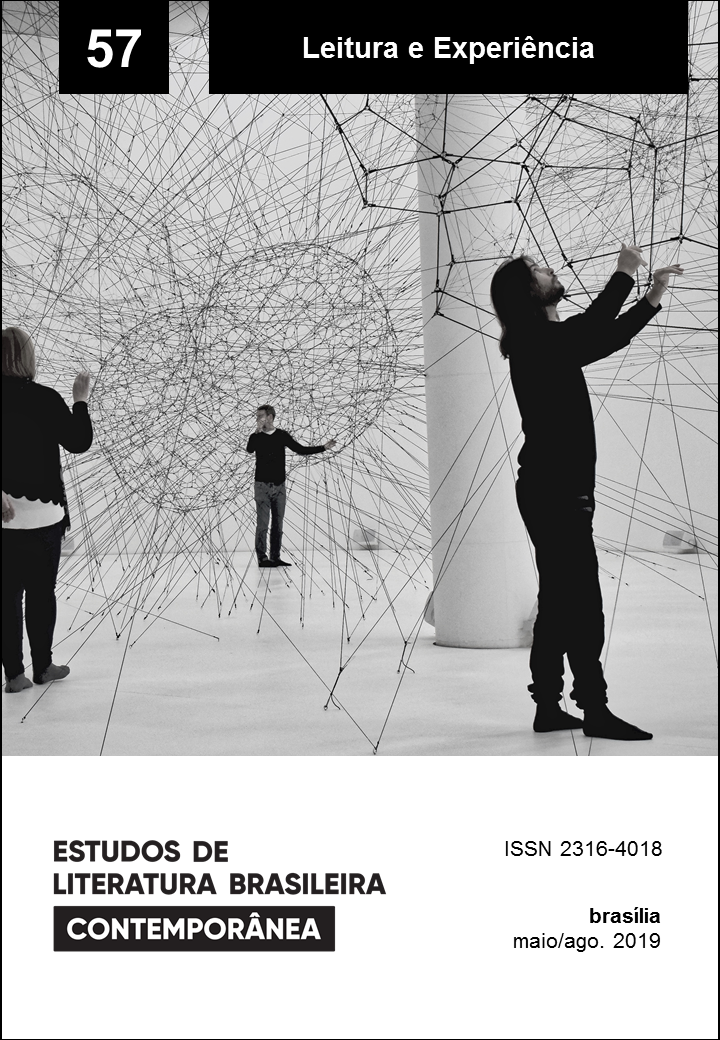Towards a marginal means: Mário de Andrade’s question and Oswald de Andrade’s solutions in Cacaso’s poetics
DOI:
https://doi.org/10.1590/2316-40185721Keywords:
Cacaso, marginal poetry, poeticsAbstract
The relationship between the so-called “marginal” poetry and the modernist poetry of 1922 is a frequent cliché within the small but prolific critical reception of the poets of the 1970s. The purpose of the article that follows is to establish what is actually modernist in the poetry of the 1970s. We adopt the relationship between Cacaso’s criticism and poetry on the side of “marginal” poetry, and the aesthetics of Mario de Andrade and Oswald de Andrade on the modernist side, to point out the similarities and differences between the “marginal” and the modernists.
Downloads
References
ALVIM, Francisco (1988). Poesia reunida. São Paulo: Duas cidades.
ANDRADE, Mário de (1963). O baile das quatro artes. São Paulo: Martins Fontes.
ANDRADE, Mário de (1978). Aspectos da literatura brasileira. São Paulo: Martins Fontes.
ANDRADE, Mário de (1980). Obra imatura. São Paulo: Martins Fontes; Belo Horizonte: Itatiaia.
ANDRADE, Oswald de (1972). Poesias reunidas. Rio de Janeiro: Civilização Brasileira.
ANDRADE, Oswald de (1997). Manifesto Pau-Brasil. In: TELLES, Gilberto Mendonça. Vanguarda européia e modernismo brasileiro. Petrópolis, RJ: Vozes. p. 326-331.
ARRIGUCCI Jr, David (2001). Humildade, paixão e morte: a poesia de Manuel Bandeira. São Paulo: Companhia das Letras.
BANDEIRA, Manuel (2007). Estrela da vida inteira. Rio de Janeiro: Nova Fronteira.
BRITO, Antônio Carlos de (Cacaso) (1975). Beijo na boca. Rio de Janeiro: Edição do Autor.
BRITO, Antônio Carlos de (Cacaso) (1978). Na corda bamba. Rio de Janeiro: Edição do Autor.
BRITO, Antônio Carlos de (Cacaso) (1997). Não quero prosa. Campinas: Editora da Unicamp; Rio de Janeiro: Editora da UFRJ.
BRITO, Antônio Carlos de (Cacaso) (2000). Beijo na boca. São Paulo: 7Letras.
BRITO, Antônio Carlos de (Cacaso) (2002). Lero-lero. São Paulo: Cosac & Naify.
CAMPOS, Haroldo de (1971). Uma poética da radicalidade. In: ANDRADE, Oswald de. Poesias reunidas de Oswald de Andrade. Rio de Janeiro: Civilização Brasileira. p. 9-62.
DANTAS, Vinicius (1991). A poesia de Oswald de Andrade. Novos estudos, São Paulo, v. 2, n. 30, p. 191-203, jul. 1991.
DANTAS, Vinicius; SIMON, Iumna. Poesia ruim, sociedade pior. Novos estudos, São Paulo, v. 2, n. 12, p. 48-61, jun. 1985.
HOLLANDA, Heloísa Buarque (2000). Entrevista com Heloísa Buarque de Hollanda. Inimigo rumor, Rio de Janeiro, n. 8, p. 98-110, mai. 2000.
HOLLANDA, Heloísa Buarque (2002). Entrevista com Charles Peixoto sobre Cacaso. Disponível em: <https://bit.ly/2U7q2BH>. Acesso em 25 jan. 2018.
LAFETÁ, João Luiz (2000). 1930: a crítica e o modernismo. São Paulo: Duas Cidades; Editora 34.
SCHWARZ, Roberto (1965) O psicologismo em Mário de Andrade. In: SCHWARZ, Roberto. A sereia e o desconfiado. São Paulo: Duas cidades.
SCHWARZ, Roberto (1987). A carroça, o bonde e poeta modernista. In: SCHWARZ, Roberto. Que horas são? São Paulo: Companhia das Letras.
SCHWARZ, Roberto (2002). No país do elefante. Folha de S. Paulo, São Paulo, Caderno Mais!, p. 6, 10 mar. 2002.
SÜSSEKIND, Flora (1985). Literatura e vida literária: polêmicas, diários e retratos. Rio de Janeiro: Jorge Zahar.
Published
How to Cite
Issue
Section
License
Authors who publish in this journal agree to the following terms:
a) The authors maintain the copyright and grant the journal the right of first publication, the work being simultaneously licensed under the Creative Commons Attribution License-Non Commercial 4.0 which allows the sharing of the work with acknowledgment of the authorship of the work and publication this journal.
b) Authors are authorized to enter into additional contracts separately, for non-exclusive distribution of the version of the work published in this journal (eg publish in institutional repository or as a book chapter), with authorship recognition and publication in this journal.
c) Authors are allowed and encouraged to publish and distribute their work online (eg in institutional repositories or on their personal page) after the editorial process, as this can generate productive changes, as well as increase the impact and citation of published work (See The Effect of Free Access).
d) The authors of the approved works authorize the magazine to, after publication, transfer its content for reproduction in content crawlers, virtual libraries and the like.
e) The authors assume that the texts submitted to the publication are of their original creation, being fully responsible for their content in the event of possible opposition by third parties.


